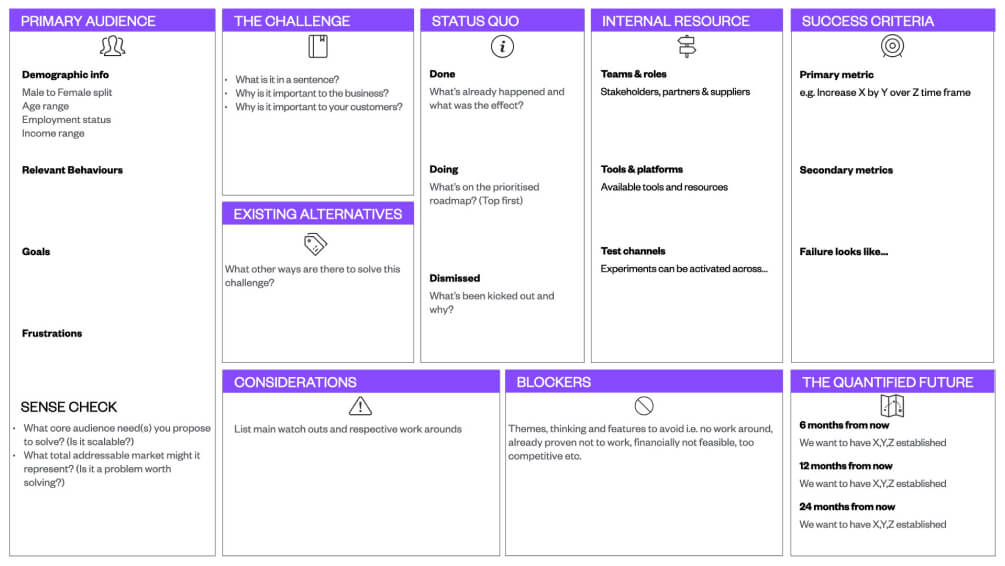This article is part of a series focused on how to introduce, explain, and condense complex thinking into a single-page view so that other people can easily understand you.
It all started with the Business Model Canvas
The free templates in this series of blog posts are inspired by Alex Osterwalder and his crew.
We used their principles when we created our creative brief template that we use with our clients, and found that this was exactly what they wanted. We know they're not alone in this thinking, which is why we want to make this free creative brief template available for anyone else to use for their next creative projects.
Whether the brief is for an advertising campaign, distribution plan, design projects or any other specific topic of creative work. These canvases and free creative briefs serve as an excellent tool for the creative teams/graphic designers/key stakeholders/creative project manager or any internal team to ensure all key points are covered.

Why are canvases so helpful?
The simplicity of the 1-page model is its secret power. By having all the moving parts viewable as a whole and keeping the amount of information that can be applied to a minimum, it does two things:
1 - as each section is limited for space, it constrains the author to write only the most relevant information for the new project.
2 - it takes away the mental load from the author of knowing what must be covered and allows them to focus because you complete it on rails.
Canvases help improve efficiency during the thinking process, with all the information required for your brief just being the key details, meaning little overall review is required initially. By only including these in your free creative brief template, it saves time and energy because you can just get right down to it, rather than spending that time and energy thinking about the thinking.

What is a creative brief?
Normally presented in short-form (just a few paragraphs long), a project brief is usually an overview text document that outlines the project plan, project goals, and target audience, and offers any relevant background information or key information, or key messaging, for the content brief like how the project supports the brand's mission statement and brand voice. Think of it like meta descriptions for web pages. It is a vital document for the team and especially any new hires.
Sometimes they might include other elements like a bit of company background or brand background, contact information, or even the project budget, for example. Essentially, all the important details you'll need to kick start a creative project and keep it on track.
A project brief should of course also give the team the scope of the project you wish to create.

However, if you need more information, you shouldn't hesitate to ask your client - they should be happy to answer any questions. The more details you have about the general history of the company the better.
Even if it's just the key parts in a short document, your creative team will have a better sense of the scope of the project. The same goes for requesting feedback from the client later on.
Quick Tips
The key game plan to write a brief, is that, well, to keep it brief. Short and sweet and packed with the most important points in the same page with a low word count is how we like them. The more you write and the more unnecessary jargon you use replaces the actually useful crucial points which is lost.
It's also important not to confuse a creative brief with a proposal - they are two very different documents.

What are briefs for?
Briefs are the starting point for any successful project.
They're packed with vital written content from the client to give the team a clear idea of the project and its objectives, and to create a shared level of basic understanding between all team members and the client company. With this, a successful project is closer within reach.
Without this basic level of understanding amongst the team, it can be difficult to get a creative project off the ground or conduct any research.
The ThinkSprint Briefing Canvas
To better answer the question of how to write a brief, we created the ThinkSprint Briefing Canvas as a free creative brief template because creating a good brief is fundamentally important to a good outcome for all types of projects.
The thing is it's not an easy thing to do - it never is. If you're a few degrees out at the start of your creative project, where you end up can be way off the mark by the time you're writing the final content.
Our brief template is split into nine sections to ensure you've covered all the critical bases, construct a solid overview, and are leaving as little room for interpretation as possible. Identifying the most important elements and keeping them clear and concise are the key fundamentals of a good brief.
(If you want a free copy of this template as a PowerPoint or Keynote file, please request it at the bottom of this page.)

You may find that some sections of your brief will not be as relevant as others, and only require a short description, but that shouldn't stop you from carefully considering each prompt. Hopefully it will jog an important detail in your mind that you may not have considered sharing.
Here are a few more details on each section of the Briefing Canvas to help define and guide your thinking...
Primary audience - the "target audience"
The primary audience, or target audience, are the individuals you want to benefit from your creative projects. (And, in turn, you benefit from them.)
Our Briefing Canvas tool includes the typical overview considerations for marketing campaigns like customer demographics and goals, but also the key behaviours and frustrations research of your target audience to give the reader additional context.
We also included a to help ensure that you've identified the right target audience for your projects in the first place. In other words, do they have a need that you can meet? Are they the biggest market opportunity? This is why research is a vital step, and can help answer questions that arise during the briefing process.
The challenge
This is where you communicate what the challenge your project is going to solve is, outline why it's important to the company, and how it feeds into the company objectives. However it is essential for project management to get this right.
There is no definitive style guide, but try to write this as tightly as you can, and pack in as many relevant details as possible. The more precise your writing is, the better, as it shows you know exactly what needs to be done. You want to boost confidence in the project stakeholders.

Existing alternatives
It's always helpful to anchor your challenge to the ways a problem is being solved currently. This highlights the different perspectives at play, and can help your creative briefs and project goals stand out from your competitors. Stakeholders want to see creative solutions with a real life application
For example, before the Business Model Canvas came to be, the existing alternative to approaching a team project was a 20-page business plan. Both can help you achieve the same thing, but they are significantly different in approach.
The status quo
Even before you get to writing a creative brief, it's likely that things regarding the project have already happened like the project name for example. Some of these things would have been good, and others not so much.
Laying these actions out, both the good and bad, adds an element of self-reflection and evaluation to your creative brief, but this also serves a functional purpose.
An overview of what has already happened will either help your creative team avoid going down paths that lead to nowhere again, or prompt further questions about previous successes and how it can be replicated and integrated into new thinking. It's important to learn from previous research and feedback.
It's a good idea to continue this review process even after the brief is complete.

Internal resources
Take stock of all the resources your team currently has at your disposal to support the project so that solutions can take these into account.
Any statistics or metrics like buying behaviors and pain points need to be accessible. Your project manager should then be able to get ahold of any company resources, like marketing assets for example, you might need to see the project come to life.
For example, you might have a killer analytics tool that could be worked into a digital product, so the sooner resources like this are involved in the brief, the better.
Success criteria
How does one measure success?
It's always good to stick to one metric as the measure of success in order to promote focus and reduce confusion. For example, if your project is a digital product, then you could measure success by the number of downloads increasing.
How does one measure Failure?
At the same time, call out what project failure might look like. This way you bookend expectations from winning to losing.
By creating these bookends, you can manage your team's perceptions and the client's expectations.

Considerations
Be mindful of those rogue banana skins in your path that could throw the project off-track and cause delays. Some will be easier to spot than others, but that doesn't make them any less distracting.
For example, the client may have a period of time off during their brand research project, like a national holiday, so who will your team contact at the company during this period of time if they have any questions or need to touch base?
If you can identify these considerations early enough, you'll be able to avoid them, create preemtive solutions, or fix yourself before any real damage can occur.
Blockers
Spelling out all the "no-go areas" at the beginning of a project is important so that no effort is wasted on them.
It's worth spending a good amount of time racking your brain because it's easy to miss things in the white papers such as regulatory issues, financial constraints, or even any internal politics (which you would obviously want to be subtle about).
Set them out clearly in your project management brief so the client is also aware of them - they may have missed them too.
The quantified future
This is useful because it gives the client and stakeholders some tangible context of the creative project manager's ambition. You anchor what goals you hope to achieve over time to the exact actions and objectives.
In conclusion, remember one thing - a great creative brief document is the start of a great project.
Download all the canvases in editable Keynote format
See the next part in this series - The Concept Canvas
